Fun Facts
Heat sensitive
The sex of turtle hatchlings depends on the temperature the egg is incubated at. If it is incubated below 28.9 degrees then the hatchlings tend to be male and above 28.9 degrees, they are mostly female.
Elusive
The Annam leaf turtle had not been observed in the wild by scientists for 65 years between 1941 and 2006.
Seasons change
Their natural habitat in central Vietnam has distinct dry and wet seasons. They have been known to be found in the leaf litter of bamboo trees during the dry season and clinging to tree branches during floods.

